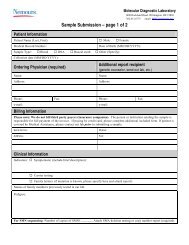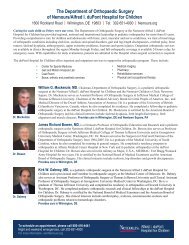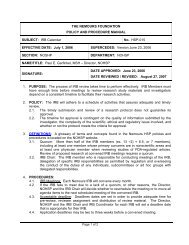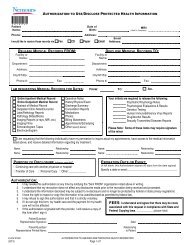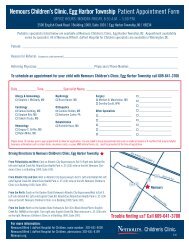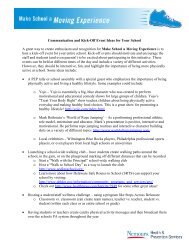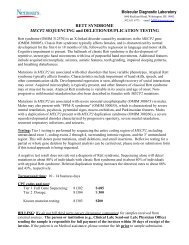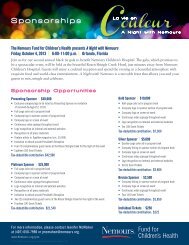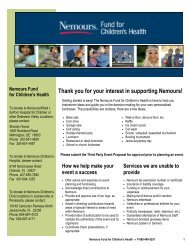Best Practices for Healthy Eating Guide - Nemours
Best Practices for Healthy Eating Guide - Nemours
Best Practices for Healthy Eating Guide - Nemours
You also want an ePaper? Increase the reach of your titles
YUMPU automatically turns print PDFs into web optimized ePapers that Google loves.
Glossary of Terms<br />
Added Sugars – Sugars and syrups that are added to<br />
foods during processing or preparation. Added sugars<br />
do not include naturally-occurring sugars such as those<br />
found in milk and fruits.<br />
Basic Food Groups – In the USDA meal pattern, the<br />
basic food groups are grains; fruits; vegetables; milk,<br />
yogurt, and cheese (dairy); and meat, poultry, fish, dried<br />
peas and beans, eggs, and nuts (protein). In the CACFP<br />
meal pattern, the basic food groups (also called “meal<br />
components”) are grains and breads; milk; meats and<br />
meat alternates; and fruits and vegetables. 1<br />
Cardiovascular Disease – Refers to diseases of the heart<br />
and diseases of the blood vessels (arteries, capillaries,<br />
veins) within a person’s entire body, such as the brain,<br />
legs and lungs. 1<br />
Cheese Food – A processed cheese prepared by mixing<br />
one or more cheese ingredients with one or more dairy<br />
ingredients into a homogeneous plastic mass, which<br />
reduces the amount of cheese in the finished product.<br />
It must contain at least 51% of the cheese ingredient<br />
by weight, have a moisture content less than 44%, and<br />
contain at least 23% milkfat. 2<br />
Cheese Product – A processed cheese that does not meet<br />
the maximum moisture content of 43% and/or the 47%<br />
minimum milkfat standards of processed cheese. 2<br />
Cholesterol – A sterol present in all animal tissues that<br />
when ingested by humans, turns into a soft, fatty, waxlike<br />
substance in the bloodstream. It is necessary in the<br />
production of cell membranes and some hormones, but<br />
too much cholesterol in the blood is a major risk <strong>for</strong><br />
coronary heart disease (which leads to heart attack) and<br />
<strong>for</strong> stroke. There is no evidence <strong>for</strong> a dietary requirement<br />
<strong>for</strong> cholesterol. 1, 6<br />
Chronic Diseases – such as heart disease, cancer and<br />
diabetes—are the leading causes of death and disability<br />
in the United States. These diseases account <strong>for</strong> seven<br />
of every ten deaths and affect the quality of life of<br />
90 million Americans. Although chronic diseases are<br />
among the most common and costly health problems,<br />
they are also among the most preventable. Adopting<br />
healthy behaviors such as eating nutritious foods, being<br />
physically active and avoiding tobacco use can prevent or<br />
control the devastating effects of these diseases. 1<br />
Combination Food – A single serving of a food item that<br />
contains two or more of the required meal components<br />
(e.g., pizza, chef salad).<br />
Dietary Fiber – Typically refers to nondigestable<br />
carbohydrates from plant foods such as legumes<br />
(e.g., peas and beans), oats, barley, some fruits and<br />
fruit juices (e.g., prunes, plums and apples), some<br />
vegetables (e.g., broccoli, carrots and celery), nuts,<br />
seeds and whole grains. 1<br />
Discretionary Calorie Allowance – The calories remaining<br />
in a person’s energy allowance after he/she has consumed<br />
adequate calories from healthful foods, i.e. foods in low-fat<br />
or no added sugar <strong>for</strong>ms. These “left-over” calories can be<br />
“spent” on <strong>for</strong>ms of foods that are not the most nutrient<br />
dense (e.g., whole milk rather than fat-free milk) or may be<br />
additions to foods (e.g., salad dressing, sugar, butter). 1<br />
Heart Disease – A narrowing of the small blood vessels<br />
that supply blood and oxygen to the heart (coronary<br />
arteries). 1<br />
Monounsaturated Fatty Acids (MUFAs) – Are liquid at<br />
room temperature and are found in canola, olive and<br />
peanut oils. MUFAs lower total cholesterol, lower bad<br />
cholesterol (LDL) and also raise good cholesterol (HDL).<br />
These are healthy fats. 4<br />
Nutrient-Dense Foods – Foods that provide substantial<br />
amounts of vitamins, minerals and other nutrients and<br />
relatively fewer calories. 1 Nutrient-dense foods are <strong>for</strong>ms<br />
of foods that are lean or low in solid fats and without<br />
added solid fats, sugars, starches, or sodium and that<br />
retain naturally-occurring components such as fiber.<br />
<strong>Best</strong> <strong>Practices</strong> <strong>for</strong> <strong>Healthy</strong> <strong>Eating</strong> 3



